To read or print a PDF of this report, click here.
Executive Summary
In the grim days following the mass shooting in Orlando, Florida, news commentator and retired Lieutenant Colonel Ralph Peters appeared on Fox News, saying: “Not all Muslims are terrorists, but virtually all terrorists are Muslim.” Peters’s statement represents the sort of venomous rhetoric that has emerged all too often this election. Republican presidential nominee Donald Trump has put an immigration ban on Muslims at the core of his nativist pitch to voters, alleging that American Muslims and mosques are knowingly harboring terrorists.
While many Americans, including President Obama, have spoken out against Trump’s characterization of American Muslims as terrorists, there has been little opposition to the premise that all terrorists are Muslims. The prevalence of Islamophobia has been coupled with a selective definition of terror under US law, contributing to the belief that all terrorists are Muslims and hence that all Muslims be viewed with suspicion, justifiably hated, excoriated, and even banned. At the same time, amplification by social media reinforces hostile political rhetoric, making legislative reform that protects Muslims as effectively as the rest of the population more difficult.
Hate speech against Muslims is not simply tolerated and largely unpunished, but normalized into a valid political position.
This paper dissects the premise that terror is a particularly Muslim problem and analyzes the key role that social media is playing in this issue. The paper begins with a quantitative snapshot of both anti-Muslim and anti-Islamophobic Google searches and statements made on social media. It then moves to a qualitative analysis of the low rates of reporting and prosecution of hate crimes against Muslims, paying particular attention to differing standards of proof required for these prosecutions. The second section looks at terror prosecutions of Muslims, noting how speech—and especially online speech—is treated very differently by courts when it involves Muslim American defendants and the mere possibility of terror connections. In paying particular attention to prosecutions under the Material Support for Terrorism Statute, we note how concerns raised in the prosecutorial context of hate crimes (such as requirements of intent and purposefulness) are summarily discarded when they arise in relation to terrorism cases.
The analysis reveals a deep double standard between the identification and conviction of domestic and foreign terrorism. Under US law as it exists today, there is no provision criminalizing the material support of a domestic terror organization. This means that statements made by white supremacist groups that incite violence against minorities are provided First Amendment protection and cannot be prosecuted without meeting a very high standard of proof. The consequence is that hate speech against Muslims is not simply tolerated and largely unpunished, but normalized into a valid political position. Second, there is no legislation criminalizing material support for domestic terrorism, or even actual acts of domestic terrorism. What has no legal reality in turn has no moral or social reality. The statement that “all terrorists are Muslim” is created and affirmed in America by the language of statutes that recognize only “foreign” organizations as the sources of terrorist acts.
There are different labels and legal standards for “hate speech” and “hate crime” as compared to “material support for terror” or “conspiracy to commit a terrorist act.” Convictions are made on the basis of who engages in them and where the organization is located instead of the actual act or speech being criminalized. In this way, domestic terror is rendered invisible, and the imagined threat of foreign terror magnified, its incipient paranoia implicating all American Muslims within its folds of suspicion, surveillance, and discrimination. All forms of terror should be equally punishable, especially in a legal system that justifies pre-emptive policing and already monitors social media platforms and speech for potential extremists.
Key Findings
- A survey of online activity (Google searches, Tweets, and Facebook posts) reveals Islamophobic statements are widespread. On average, violent anti-Muslim Google search terms are about half as popular as anti-Islamophobic searches. In this paper’s Twitter dataset, for every ten tweets containing an anti-Islamophobic message, there were seven containing anti-Muslim keywords. On Facebook, posts containing anti-Muslim language outnumbered posts containing anti-Islamophobic language. On candidates’ Facebook pages, there were four times as many anti-Muslim posts as anti-Islamophobic posts in the period under study. The Anti-Defamation League and the Southern Poverty Law Center suggest a prevalence of such rhetoric can lead to an increase in the number of hate crimes against Muslims.
- Prosecution and reporting of hate crimes against Muslims remains low; in cases like Hicks v. United States and the recent murder of a Muslim Imam in Queens reveal a reluctance to charge attackers under the federal or state hate crime statutes, consequently making “hate crimes” against Muslims invisible.
- Under Elonis v. United States, the Supreme Court of the United States deemed that threats of violence against neighbors, co-workers, and a kindergarten class posted on Facebook were deemed protected by the First Amendment of the United States Constitution and not a “true threat” unless the prosecution could prove subjective rather than objective intent, setting a precedent for making hateful speech online difficult to prosecute.1
- But the First Amendment protections afforded to others are eroded for Muslims, particularly when it comes to their online activity. Under Mehanna v. United States, free speech protections are not considered when evaluating the defendants’ online postings in support of ISIS. The fact that others who sympathize with designated foreign terrorist organizations frequented websites visited by the defendant was adequate proof of co-ordination under the Material Support for Terrorism Statute. Furthermore, purely online actions can constitute the basis for conviction under the Material Support for Terrorism Statute without consideration of recklessness or negligence.
- The language of the Material Support for Terrorism Statute only permits conviction for the support of foreign terror organizations. The US does not currently have any legislation criminalizing domestic terrorism or material support for domestic terrorism even though it has been recognized by officials at the Department of Justice as a greater threat than foreign terrorism.
Recommendations
- As is the case in the United Kingdom, the US Material Support for Terrorism Statute needs to be amended to apply to all and not only “foreign” terror organizations.
- A single standard of First Amendment protections should be applied in cases involving threats of hate related violence and material support of terror online.
- Given the escalating numbers of hate speech against Muslims online, a better reporting and enforcement system needs to be developed and implemented for hate speech and hate crimes against American Muslims. The low reporting rate of hate crimes suggests that most American Muslims do not feel comfortable taking their experiences to the FBI and other institutions. For every local police department that has an anti-terror task force, there should be one devoted to the investigation and prosecution of hate crimes with adequate allotted resources to do so.
- As private corporations, social media platforms like Facebook and Twitter must do a better job of implementing their own guidelines that already prohibit the posting of hate material against a particular group. This requires initiative from these platforms because, unlike the posting of pro-terror materials, posting Islamophobic material is not a crime in the US.2
Introduction
“Donald Trump is calling for a total and complete shutdown of Muslims entering the United States until our country’s representative can figure out what’s going on.” These words are from the Donald Trump campaign’s “Statement on Preventing Muslim Immigration,” published on December 7, 2015. Trump’s invective, and his touting of a ban on Muslims—recently restated as a ban of immigration from countries that have terrorist activity, and then to “extreme vetting”—has put Muslims front and center in a divisive electoral campaign.
Unlike any other presidential candidate, Trump is an active personal user of social media and has used his Twitter account to reiterate and restate his Islamophobic positions, galvanizing his followers to do the same. In January 2016, Trump re-tweeted an anonymous Nazi sympathizer and white supremacist with the Twitter handle @WhiteGenocideTM. Two days later, Trump retweeted another account, @EustaceFash, which also features #whitegenocide in its profile. Reports abound of Trump supporters outside rallies shouting, “Kill Muslims; Kill Them All.”
In a speech in South Carolina in February, 2016, Trump told a fabricated story involving General John Pershing’s execution of Muslim prisoners in the Philippines: “He took fifty bullets, and he dipped them in pig’s blood, and he had his men load his rifles, and he lined up the fifty people, and they shot forty-nine of those people. And [to] the fiftieth person, he said, ‘You go back to your people and you tell them what happened.’ And for twenty-five years there wasn’t a problem, okay?” The implied moral of this fabricated story is simple: that you have to be tough on Muslims, perhaps even kill some, to teach them a lesson. On March 9, 2016, in an interview with CNN’s Anderson Cooper, Trump reiterated his anti-Muslim stance in broader terms: “I think Islam hates us.”
March 9, 2016, in an interview with Anderson Cooper, Trump reiterated his anti-Muslim stance in broader terms: ‘I think Islam hates us.’
Trump’s repeated conflation of Muslims as terrorists has promoted a rhetorical climate that permits and encourages Islamophobia. This paper attempts to put Trump’s statements in the context of perceptions of American Muslims and considers the role they play in normalizing the harassment and even violent intentions against them.
It is one thing to say that Islamophobia exists, but to really understand the threats it poses to American Muslims and to the Constitution’s principles of freedom of expression, freedom from discrimination based on race and religion, and more generally equality, it is necessary to dissect the anatomy of Islamophobia and how it relates to social media. How widespread is it? How has it seeped into existing precepts of permissible and criminal behavior? It is such a dissection that is the project of this paper: Using data from Google searches, Twitter hashtags, and Facebook posts on Trump’s and Hillary Clinton’s pages, we present a snapshot of the prevalence of the increasingly partisan anti-Muslim sentiment in the lead-up to the November election.
The paper considers the use of social media both in perpetuating hatred against Muslims and prosecuting Muslims for terrorism-related crimes. In this sense, the paper intends to look at a spectrum of using social media language as an indicator of nefarious intent. Both when non-Muslims use hashtags such as #banislam, #killmuslims, and #islamisterror, and when alleged Muslim terror suspects engage in social media actions such as reposting videos from extremist groups or posting or re-tweeting from Twitter accounts that seem to have extremist allegiances. This juxtaposition allows us to see how different standards are applied when threatening or hate speech implicates the civil rights of Muslim minorities who are the targets of such speech versus when members of the same Muslim minority are being evaluated for alleged ties with extremist groups.
Section One of the paper looks at when and where spikes in online rhetoric against Muslims (and in defense of Muslims) happen and how they connect both to terror attacks within the United States (such as recent incidents in Orlando and San Bernardino) and to geographical locations in red and blue states. It compares the prevalence of Islamophobic searches and hashtags like “#killmuslims” and “#banmuslims” to those that belie a concern for discrimination and targeting of Muslims (“#islamophobia” and “#stophate”). In addition to Twitter and Facebook data, this section also looks at Google search prevalence, an indicator that has been shown in previous studies to be an accurate predictor of racial animus. This section will also look at reports on hate crimes against Muslims to understand how online Islamophobia connects to hate crimes against Muslims in real life. Finally, this section looks at what sorts of civil rights remedies, if any, are available to Muslims and what concerns for freedom of speech are reflected in the adjudication of these cases.
Undergirding the climate of the current U.S. election are larger questions regarding what sorts of speech are considered permissible, threatening, and incriminating as they relate to American Muslims in post-9/11 America.
Section Two deals with social media activity and its use in prosecutions of Muslims under the Material Support for Terrorism Statute, the basis for most domestic terrorism indictments. Using the total numbers of cases filed under this statute, it investigates how frequently social media activity—such as maintaining Twitter accounts, posting and liking on Facebook, and participating in chat forums—is used as the basis for “material support for terrorism.” Hate speech is often considered un-actionable in court and protected under the First Amendment when it promises violence against Muslims, but considered unproblematic when presented as the basis for the material support for terrorism against a Muslim defendant. This comparison reveals the different evidentiary standards applied to the same speech based on who engages in it, and the legal roots for why hate crimes are not considered acts of domestic terrorism. Finally, this section looks at what, if any, First Amendment concerns are considered by courts when social media activity is used as the basis for material support for terror.
The final section of the paper looks at how other countries from the European Union tackle the balance between online hate speech and terror prosecutions. It looks at the standards of proof in relation to online social media activity utilized by the European Union, where Muslims are also a religious minority and where they are also subject to both online hate (and actual hate crimes) as well as terror indictments.
Undergirding the climate of the current US election are larger questions regarding what sorts of speech are considered permissible, threatening, and incriminating as they relate to American Muslims in post-9/11 America. This is not something that can be considered the momentary mess of a highly unusual election year. Instead, the disjunction between the lack of legal recourse available to a minority group as either victim or criminal exposes the weakness of a democratic system whose core values rest on procedural justice. A serious and urgent consideration is necessary of the double standard that exists between toleration of hate speech by a racial and religious majority as an unavoidable corollary of maintaining the freedom of cyberspace and the ease with which similar speech by American Muslims is made the basis for convictions under material support for terrorism.
Hate Crimes Against Muslims
Even though we spend an increasingly larger fraction of our time navigating and participating in conversations and activities based in cyberspace, the virtual realm is often considered less real than the physical world, with different rules. In her book Hate Crimes in Cyberspace (2016), law professor Danielle Keats Citron3 explains how this cultural premise of a lesser reality translates into the notion that “more aggression should be tolerated in cyberspace than in real space” and that “virtual spaces are cordoned off from physical ones.” This premise, Citron argues, is untrue, and the work of cyber law scholars such as Julie Cohen has illustrated Citron’s thesis that “logging off,” so to speak, is largely a myth and that “harassing posts are situated wherever there are individuals who view them and thus they have a profound influence over the lives of victims.” The myth of cyberspace as a lesser reality has permitted it to become another realm where minorities—such as women, Muslims, and homosexuals—are targeted, often with few or no consequences for the harassers.
Google Searches as Indicators and Predictors of Hate Crimes
The connection between online behavior and racial animus has been studied by social scientists on the basis of data from the 2012 electoral race. One such study of racial animus in the 2012 US presidential election found that the percentage of Google searches including hate speech or racially charged language serves as a meaningful proxy for levels of racial animus in a given area, and predicted Obama’s vote share with greater accuracy than survey data.4 The study finds that juxtaposing what people search for online and their physical location is a reliable predictor of how they vote in real life elections. One explanation for the study’s findings is that the private nature of Google searches makes Google data less likely to be marred by social desirability bias. This means that people frequently express socially taboo thoughts in Google searches (as the large number of searches for pornography and sensitive health information suggests5), typing in the search bar thoughts and questions they would not share with even closes friends and family. Unlike social media activity (which can also engage in the presentation of such views via fake pseudonymous profiles), Google searches present what the majority of people believe to be “unseen” behavior. Recent work by Seth Stephens-Davidowitz also suggests that the incidence of Islamophobic hate speech in American Google searches is correlated with the frequency of hate crimes. This bears particular relevance to the current electoral campaign, where Islam and Muslims have been front and center and where the statements of the GOP candidate have declared Muslims worthy of a blanket immigration ban.
A look at the frequency with which Americans are searching for Islamophobic terms, where most of these searches take place, and when spikes in these searches occur, then, can approximate how widespread Islamophobia is among Americans. Contrasting this data against the prevalence of Google searches related to Islamophobia (a proxy for concern about anti-Muslim bias) allows us to see how the frequency of expressions of Islamophobia compares with that of anti-Islamophobic views among Americans.
As the normalized plot of Google Trends data below indicates, the term “Islamophobia” was more commonly searched than “Kill Muslims” every week for the past year. According to Google Keyword Planner, which provides the average monthly search volume of a given keyword, over the past twelve months, the monthly average number of searches for “Kill Muslims” and variations (“Kill all Muslims,” “Kill the Muslims”) was 1,890, with a peak of 6,590 searches in November, 2015, and a low of 690 searches in August, 2015. By contrast, the monthly average number of searches for “Islamophobia” was 22,200 with a peak in November of 2015, of 49,500 and a low in August of 2015, of 5,400. There were peaks in both anti-Muslim and Islamophobia Google searches following the Paris attacks on November 13, 2015, the San Bernardino attack on December 2, 2015, and the Orlando shooting on June 12, 2016. There is also a large spike in the search term “Islamophobia” on the anniversary of 9/11, and a large spike in “Kill Muslims” following the Brussels attack.
Google Trends data also show the “top related topics” or most-searched topics by Google users who searched for the keywords in question. Among the top related topics for those searching “Kill Muslims” were the terms “ISIS,” “Christianity,” “Donald Trump,” “Terrorism,” “Jewish People,” “Bible,” “Jesus,” and “Barack Obama.” The top related topics for those searching “Islamophobia” included “Racism,” “Xenophobia,” “Donald Trump,” “September 11,” “Refugee,” and “Discrimination.” The prevalence of discussion of Donald Trump among users who searched both Islamophobic and anti-Islamophobic keywords strengthens the sense that Trump’s candidacy has served to increase the saliency of anti-Muslim bias as an election issue.
Weekly Relative Frequency of Google Searches for “Kill Muslims” or “Islamophobia” (August 2015–August 2016)
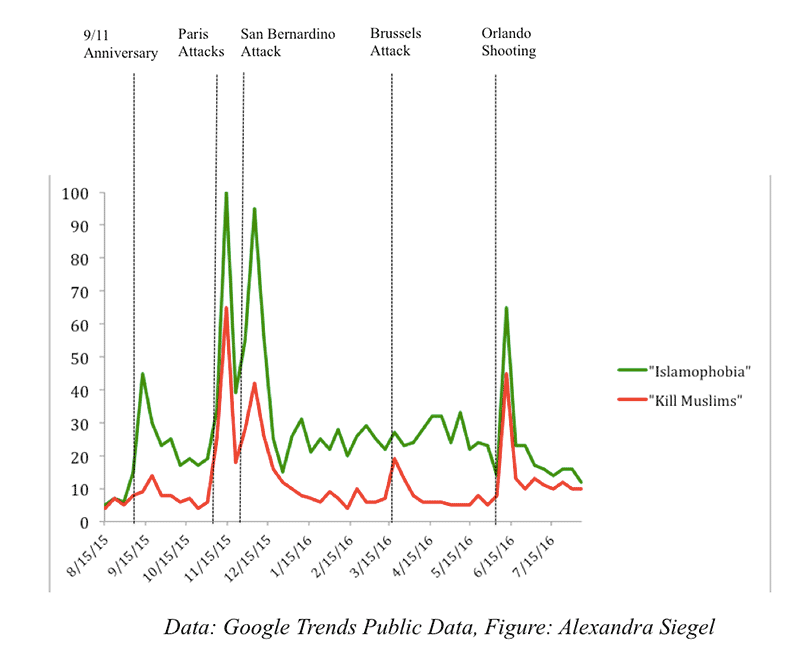
The regional breakdown of Google Trends data suggests that searches for both “Islamophobia” and “Kill Muslims” are prevalent across the country.
Note: Numbers on the Y-axis represent search interest relative to the highest point on the plot for the given region and time. A value of 100 is the peak popularity for the term. A value of 50 means that the term is half as popular. Likewise a score of 0 means the term was less than 1 percent as popular as the peak.
Variation in Relative Volume of “Islamophobia” Searches by State (August 2015–August 2016)
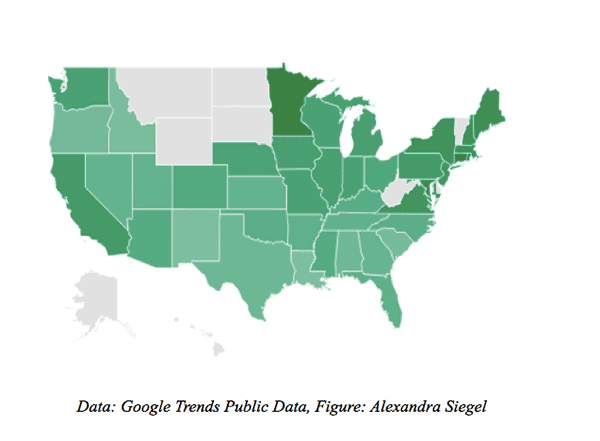
Note: Darker color indicates a higher relative search volume. Gray color indicates a very low volume of the search term.
Variation in Relative Volume of “Kill Muslims” Searches by State (August 2015–August 2016)
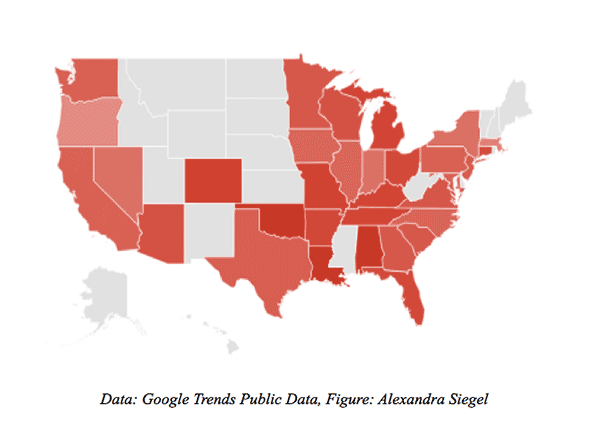
Note: Darker color indicates a higher relative search volume. Gray color indicates very low volume of the search term.
The only state in which the relative volume of searches for “Kill Muslims” outnumbered the relative volume of searches for “Islamophobia” was Louisiana. As the table below indicates, the term “Kill Muslims” had one of the highest relative frequencies in Louisiana, while the term “Islamophobia” had one of the lowest.
Relative Prevalence of “Kill Muslims” vs. “Islamophobia” Google Searches by State (Red and Blue States) (August 2015–August 2016)
|
“Kill Muslims” |
“Islamophobia” |
|
|
Minnesota (D) Rhode Island (D) Connecticut (D) Maryland (D) Maine (D) District of Columbia (D) New Hampshire (D) Massachusetts (D) New York (D) Virginia (D) New Jersey (D) California (D) Pennsylvania (D) Michigan (D) Illinois (D) Iowa (D) Washington (D) Wisconsin (D) Missouri (R) Indiana (D) Nebraska (R) Ohio (D) Colorado (D) Mississippi (R) Arizona (R) Kentucky (R) Oklahoma (R) North Carolina (D) Florida (D) Arkansas (R) Tennessee (R) Utah (R) Kansas (R) Nevada (R) Georgia (R) Texas (R) Alabama (R) Oregon (D) South Carolina (R) Idaho (R) Louisiana (R) New Mexico |
Note: This table ranks states by the relative prevalence of each search term. States are not included on this list if the relative volume of the search term is too low. Red states are states where Mitt Romney won in 2012 and blue states are where Obama won in 2012.
As can be seen, the data on Google searches present some disturbing results. It is not surprising, of course, to note that the volume of searches surges around the anniversary of the 9/11 attacks and the Orlando and San Bernardino mass shootings. However, what is notable is that the number of people who search terms like “Kill Muslims” is not significantly lower, and in one state (Louisiana) is actually greater than the number of searches for “Islamophobia.” The numbers for “Kill Muslims” also need to be considered in light of the wider patterns of hate searches outlined by Stephens-Davidowitz. In his essay “The Rise of the Hate Search,” he writes: “There are about 1,600 searches for “I hate my boss” every month in the United States. In a survey of American workers, half of the respondents said that they had left a job because they hated their boss; there are about 150 million workers in America,” leading us to the conclusion that if everyone was searching for what they were experiencing the numbers would be much higher. In this case, in November, 2015, there were about 3,600 searches in the United States for “I hate Muslims” and about 2,400 for “kill Muslims.” These Islamophobic searches likely represent a similarly tiny fraction of those who had the same thoughts but didn’t drop them into Google.
If Islamophobia search statistics are considered a proxy for sympathy toward Muslims, or concern for their rights, then “Kill Muslims” suggests exactly what it stands for: a desire for the elimination, literally the killing, of Muslims. The second statistic should be truly alarming. While hate exists in every country, those who respect the constitutional rights afforded to religious minorities should greatly outnumber those who consider killing them. Second, the fact that Islamophobia is a complex term suggests that those searching for it may not necessarily know its meaning or simply be looking for a definition while those searching for “Kill Muslims” are unlikely to be doing so. This suggests that while the numbers of people searching for Islamophobia may not actually be sympathetic to toward Muslim Americans, there is very little doubt that those searching the term “Kill Muslims” bear animus toward them. Finally, the fact that primarily Republican states rank in the top three for the “Kill Muslims” search also suggests that the rhetoric used by the Republican Party during its primary season, and then later by nominee Donald Trump, has actual implications in their adherents’ sentiments about Muslims, mirrored here in their searches for “Kill Muslims.” Since civil rights laws and protections are available to all Americans, it is troubling to see respect for the rights of American Muslims translated into a partisan issue where having a particular political affiliation can mean a refusal to support religious freedom for American Muslims.
Social Media and Islamophobia
Beyond what people Google anonymously, Twitter and Facebook data also provide key insights into the prevalence of anti-Muslim hate speech online. Like Google Trends data, studies suggest that the relative popularity of hate speech on social media serves as an early warning sign of instability and potential violence. In fact, tools have recently been developed and used by government and NGOs to measure the online prevalence of hate speech in order to predict outbreaks of violence. Such tools include Hatebase and Una Hakika—crowd-sourced databases of multilingual hate speech.6
In order to measure the relative volume of anti-Muslim hate speech on social media in the 2016 election period, this paper first relies on a Twitter dataset collected through NYU’s Social Media and Political Participation Lab. This dataset contains all mentions of Trump, Hillary, or Election 2016 from April, 2015, to July, 2016. Filtering this dataset in order to measure the prevalence of anti-Muslim and anti-Islamophobia tweets, there are 5,773,466 tweets that contain the terms “Muslim or Islam.” 83,954 of them contain anti-Muslim terms and do not contain anti-Islamophobia terms. 118,417 of the tweets referencing “Muslim” or “Islam” contain anti-Islamophobia terms and do not contain anti-Muslim terms. Tweets that contained both types of references were not included, as the sentiment of these tweets is unclear. Then, the following common hashtags were used to determine whether tweets were “anti-Muslim” or “anti-Islamophobia.”7
|
Anti-Muslim Hashtags
|
Anti-Islamophobia Hashtags |
| #islamistheproblem #stopislam #banislam #bansharia #islamisevil #deportallmuslims #badmuslims #dangerousmuslims #noislam #killallmuslims #fuckmuslims #muslimsterrorists #attackamosque |
#islamophobia #weareallmuslim #stophate #humanitywins #racism
|
In addition to Twitter data, a look at a dataset of Election 2016 Facebook data allows for a cross-platform comparison of pro- versus anti-Islamophobic sentiments. In particular, scraping recent posts on Donald Trump’s and Hillary Clinton’s Facebook pages provides further insight into the salience of anti-Muslim sentiment during the lead up to the 2016 election. While API limits only allowed us to scrape data from March of 2016 forward, we nonetheless observe interesting trends over the past several months.
Out of 4,492,925 comments on Clinton’s Facebook page and 7,670,262 comments on Trump’s Facebook page, 121,618 comments mentioned the terms “Islam” or “Muslim,” posted by 68,464 unique users. Of these posts, 9,110 contained anti-Muslim terms posted by 4,546 unique users and 2,094 contained anti-Islamophobia terms posted by 721 unique users. Again, we did not include posts that contained both anti-Muslim and anti-Islamophobia terms, as the sentiment of these posts is unclear.
The trends drawn from the data on Google searches recur in the data from Facebook and Twitter. On Twitter, as the graphs in the appendix demonstrate, the largest spikes in anti-Muslim election-related tweets occurred following the Brussels attacks and the Orlando attack. We also observe smaller spikes following the Paris attack and the San Bernardino attack. The largest spike in anti-Islamophobia tweets also occurred around the San Bernardino attack in December 2015. On Facebook, the figures in the appendix show that the biggest spike in anti-Muslim comments occurred following the Orlando attack, while the biggest spike in anti-Islamophobia comments occurred during the DNC during the Khizr Khan speech. Politicians’ Facebook pages were the one platform on which anti-Muslim rhetoric was far more prevalent than anti-Islamophobia rhetoric.
It is notable that the attacks in Orlando and San Bernardino prompted candidate statements. On the day following the Orlando shooting, Trump delivered a speech in which he asserted that “the killer, whose name I will not use or ever say, was born an Afghan of Afghan parents, who immigrated to the United States.” He also said: “Large numbers of Somali refugees in Minnesota have tried to join ISIS.” Both of these claims are untrue: Omar Mateen was born in the United States and only nine Somali Americans have ever been charged with a terror-related offense.
In the same speech, Trump interpreted President Obama and Clinton’s refusal to use the term “radical Islamic terrorist” (owing to its implication of terror as a particularly Islamic phenomenon) as actual support for extremism. Trump also falsely asserted that people in San Bernardino had known about the attacker’s intentions, but failed to report because they were concerned with racial profiling. In sum, Trump conflated Muslims with terrorists and suggested that the terrorist was not American because his parents were Afghan.
In her speech, also delivered on June 13, Clinton expressed both outrage at the horror and sympathy for the victims. Instead of using “Muslim” and “Islam” to describe the shooter, she mentioned ISIS. One of the few times the word “Muslim” did appear in her speech was when she mentioned that “they (ISIS) are slaughtering Muslims who refuse to accept their medieval ways” in an attempt to underscore that Muslims are the most common target of terror attacks.
The content of the posts on the Facebook pages of both candidates immediately following the attack reveals the consequences of these rhetorical differences, one eager to hold all Muslims and particularly American Muslims as responsible for and sympathetic to terrorism (meriting a ban) and the other who has refused to use Muslims as bait in her campaign rhetoric. Between June 12 and 14, 297 anti-Muslim comments were posted on Clinton’s official page and 703 were posted on Trump’s page. The total number (until July 2016) of anti-Muslim comments on Clinton’s page was 3,090, while the total number on Trump’s page was almost double that at 6,020.8
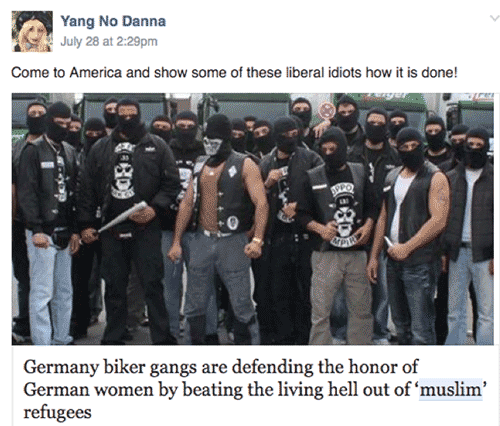
Instead of there being widespread support for constitutionally guaranteed religious freedom, Islamophobic tweets (84K) came up to almost two-thirds of the tweets that were against Islamophobia (118K). This becomes an even greater basis of concern when it is noted that most of the anti-Muslim hashtags for which data were pulled involve violent acts against Muslims or their places of worship. It is also notable that a fewer number of unique users generate a high number of anti-Islamophobia tweets relative to the number of unique users that generate Islamophobic content. This suggests the possibility that the anti-Islamophobic tweets may be produced by a small number of activists who oppose hate speech on the internet against the larger number searching, tweeting, and sharing Islamophobic material.

Looking at some of the most egregious tweets and Facebook posts underscores the potential dangers posed by the numeric proximity between those that speak out against hate groups and in favor of protecting minority rights versus those who actively believe in the extermination of Muslims and are not afraid to state their views in public. The Facebook post below, for instance, seeks to inspire white men to beat up Muslims in order to defend the honor of white women.
The anti-Muslim post below uses an anti-hate position to preach hatred against Muslims by saying that all Muslims constitute a hate group that should be banned.
The following is an example from Twitter users who are against Islamophobia and hatred. Unlike the posts above, which seek to provoke violence against Muslims or their places of worship, it shares an article about a hate crime against a Muslim student committed by an alleged Trump supporter.
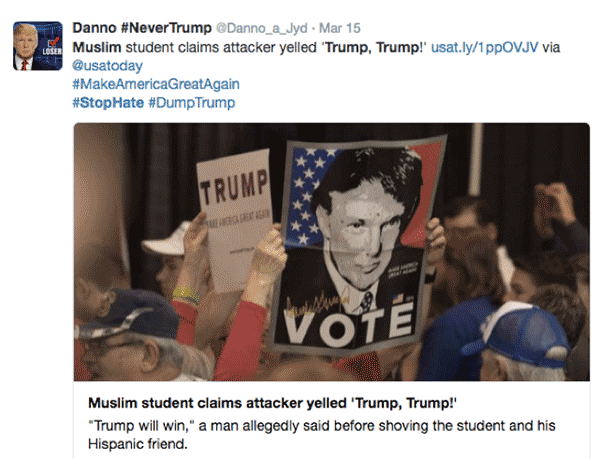
Finally, the tweet below urges others to call their electoral representatives and demand a Muslim ban. The fact that it originates from Breitbart.com, a news site whose top executive is now the CEO of Donald Trump’s electoral campaign, underscores the candidate’s particular avowal of Islamophobia as a campaign strategy.
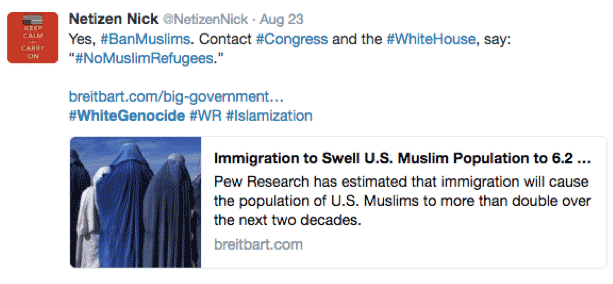
Hate Crimes Against Muslims Since June 2016
On August 13, 2016, Imam Maulana Akonjee and his assistant Thara Uddin were walking home from the Al-Furqan Jame mosque in the predominantly Muslim neighborhood of Ozone Park in Queens New York. As they were walking home, a man approached them from behind and shot them in the back of their heads. The men were transported to Jamaica Medical Center in Queens, where they were declared dead. They had been wearing visibly religious garb when they were shot.
The assailant was later identified as 35-year-old Oscar Morel, a man who lived in Brooklyn and had no prior connection to the Ozone Park Mosque. Ten minutes after he shot the Imam and his assistant, he drove his black SUV into an Iraqi man named Salim al-Shimiri, who was walking his bicycle through a crosswalk. Al-Shimiri was struck and fell to the ground, badly bruised but alive. Bystanders called the police and reported a hit and run; footage from a nearby surveillance camera saw the SUV hit the man and speed off. The murders and the hit-and-run together fueled fear among the mostly immigrant Ozone Park community.
The Council of American Islamic Relations, a Muslim civil rights group, said the incident was a hate crime a few days after the shooting: “You can’t just go up to a person, shoot them in the head, and not be motivated by hatred.” But on Friday, August 19, 2016, the District Attorney of Queens released a statement that Oscar Morel was being charged only with first-degree murder; second-degree murder would be the minimum required if he were being charged with a hate crime. As The New York Times’ report of the DA’s charging decision suggests, this was a political move, one that stayed true to the “technical” aspects of the law. While authorities expressed “deepest sympathies” for the victims, the criminal justice system did not pursue an adequate investigation into the motives for the killings.
Dismissing the possibility that crimes against, even murders of, American Muslims are motivated by hatred or Islamophobia is not exclusive to the Queens District Attorney’s Office. This penchant for ignoring the threats (and actual violence) to which Muslims are subject is even more pronounced online. When Tamim Uddin, Uddin’s nephew, posted about his uncle’s death on Facebook, a man posted, “You were warned not to mess with the West and now you must suffer thy consequences. Tick Tock…TRUMP2016. Death to all who challenge Western Civilization.”
The murder of Akonjee and Uddin is one among many hate crimes directed at Muslims during this election season. A recent report, “Protecting Pluralism: Ending Islamophobia,” prepared by the BRIDGE initiative at Georgetown University, looked at Islamophobia in two distinct time periods to get an idea of how Islamophobic rhetoric was influencing hate crimes against Muslims. The report states that during the election season (defined for their purposes as the period from March, 2015, to March, 2016) there were 160 incidents of anti-Muslim violence, including twelve murders (not including the Queens murders).
The first surge in anti-Muslim rhetoric took place in September, 2015, and was seen to correspond with an international event: the Syrian refugee crisis. November and December of 2015 saw the Paris and San Bernardino terror attacks,9 following which Trump made a call to shut down mosques and ban Muslim immigrants. Anti-Muslim attacks tripled during the following month. It is also notable that over half of the seventeen attacks during that month (also unlike previous months) were directed at mosques and Islamic schools. Attacks during this month constituted a third of all the attacks in 2015.
Federal Hate Crime Legislation and its Failure to Protect American Muslims
The Akonjee and Uddin murder in Queens was not the only incident for which authorities refused to charge an Islamophobic assailant with a hate crime. In February, 2015, a grand jury in North Carolina delivered an indictment against 46-year-old Craig Hicks for killing his Muslim neighbors, Deah Barakat, 23; Yusor Abu-Salha, 21; and Razan Abu-Salha, 19. There was no mention in the indictment of the triple murder being a hate crime. While there had been a parking dispute between the two parties, Hicks had posted many anti-religion posts on his social media accounts, and neighbors said he had become more hostile when Yusor Abu-Salha, who wore a headscarf, had moved into the apartment.
Even when crimes as egregious as murder seem to be motivated by Islamophobia, that motivation is rarely investigated or taken seriously. Unsurprisingly, this makes Muslims less likely to report hate crimes. A Pew Survey looking at FBI Hate Crime Reporting Database found that between 2011 and 2013, 180 hate crimes had been reported. However, when they posed the question anonymously to Muslims, asking them if they had been threatened or attacked, they found 6 percent of Muslims said that they had experienced such behavior. Based on the American Muslim population in 2010 (2.6 million), this means that 156,000 Muslims experienced threats and attacks. The Justice Department finds that two out of three American Muslims do not report the hate crimes they have experienced because they do not believe anything will be done about it.
The higher number is substantiated by the Google search and social media data presented at the outset of this section. The two are particularly troubling when considered in conjunction, since the increasing rate of hate incidents against Muslims suggests a possible connection between virtual hatred and real crime.
Most states have local civil rights statutes against hate crimes, but their provisions are neither uniform nor easily accessible to American Muslims. The Federal Hate Crime Statute 18 USC Section 249(A) and (B) criminalizes any act that “willfully causes bodily injury to any person or, through the use of fire, a firearm, a dangerous weapon, or an explosive or incendiary device, attempts to cause bodily injury to any person, because of the actual or perceived religion, national origin, gender, sexual orientation, gender identity, or disability of any person” but does not have any specific provision for online harassment. Despite the existence of these laws, as the Akonjee and Hicks cases illustrate, there is reticence in their utilization as a means to punish assailants acting on the basis of Islamophobia.
Elonis v. United States (2015) illustrates how challenging it is to get beyond First Amendment protections for speech when a person is threatening violence in online posts. It sets a dangerous precedent for the protection of hate speech online. In this case, Anthony Elonis was convicted under 18 USC 875(c), a Federal statute that criminalizes anyone who “transmits in interstate or foreign commerce any communication containing any threat to kidnap any person or any threat to injure the person of another.” Elonis had been posting threats to injure his co-workers, his wife, a kindergarten class, the police, and an FBI agent on Facebook. He was charged under the statute, and after the trial the judge instructed the jury that they were to make a finding of guilty if his statements constituted an “objective intent to threaten.” The jury came back with a guilty verdict using the “objective standard” of whether a reasonable person would have considered Elonis’s threats credible.
When Elonis appealed his conviction in June 2015, the US Supreme Court ruled that the wrong standard had been applied. In the Court’s view, the prosecution was required to prove not simply that an “objective” person would consider the posts as representing a threat but rather that Elonis subjectively intended the posts to be threatening. This constitutes a greater burden of proof than the objective standard. The Court’s rationale in insisting that the subjective standard be used was based on the premise that an objective standard did not adequately differentiate between innocent and accidental conduct versus purposeful and wrongful acts. It did not, however, specify what the correct jury instruction should have been in this case. The consequence of the Elonis decision is a discarding of the “objective” standard. It also established a gray area on the issue of what sort of jury instruction should accompany a finding of subjective intent to post a threat, and what factors would constitute adequate proof of “purposefulness” on the part of people who post them.
When All Speech is Serious and Meaningful
Prosecutions of American Muslims under the Material Support for Terror Statute
While First Amendment concerns loomed large in the Elonis case, with the Court reticent to limit speech or punish those engaging in it, the reverse is true for cases brought under the Material Support for Terror Statute, 18 USC 2339A through C, which criminalizes the provision of resources, training, or expertise to any of the groups listed as “terror organizations” by the United States.10 Unlike the Elonis case, where the court expressed an over-arching concern for when accidental or negligent speech could become the basis of criminal liability, no such concern is evident when actions are being considered in relation to a defendant’s intent to provide material support for a terror group.
The landmark case on the question of whether actions or speech on social media platforms (or online speech in general) can constitute material support for terror is Mehanna v. United States (2013). In this case, the defendant, Tarek Mehanna, had posted translations of various Al-Qaeda documents on a website called Tibyan; he had also posted some Al-Qaeda videos on the same site. The site was not itself operated by Al-Qaeda but was a platform where those sympathetic to Al-Qaeda and Salafi/Jihadi perspectives would exchange views.
The incipient suspicion of Muslims and prevalence of Islamophobia among the general American population nearly guarantees that American Muslim defendants will not receive a fair jury trial.
In Mehanna’s appeal to the First Circuit after his conviction at the trial level, he alleged that his online activities (to the extent that they involved posting and reposting material) were protected speech under the First Amendment11 and hence did not constitute material support for terror. Hearing his appeal, the First Circuit ruled that translations posted online constituted a “service” under the definition of the statute and elided over the First Amendment issue of whether this was protected speech. Citing a portion of a prior US Supreme Court decision in Holder v. Humanitarian Law Project (2010), the First Circuit ruled that Mehanna’s “otherwise-protected speech rises to the level of criminal material support” because the website on which he posted had some connection with Al-Qaeda. This flimsy fact, whose corroboration was based almost entirely on other pro-Al-Qaeda postings on the site, was considered adequate proof of “co-ordination” between Mehanna and Al-Qaeda.
The Mehanna decision diluted the First Amendment safeguards that the Holder case had very pointedly insisted upon even in cases under the Material Support for Terrorism Statute and reduced the proof of co-ordination requirement to a mere formality satisfied by the most cursory implication of connection. In Holder, Justice Roberts, writing for the majority, specifically stated: “All this is not to say that any future applications of the material-support statute to speech or advocacy will survive First Amendment scrutiny….We simply hold that, in prohibiting the particular forms of support that plaintiffs seek to provide to foreign terrorist groups, § 2339B does not violate the freedom of speech.”
The Supreme Court’s decision in Holder also stipulated that any “independent advocacy” by a person was not necessarily a violation of the Material Support Statute, but it left the juries at the trial level to consider what constituted evidence of co-ordination with a particular terror group. In Mehanna’s case this amounted to a trip to Yemen, where he had searched for but failed to find a terrorist training camp. The First Circuit refused to take seriously the Supreme Court’s admonition that First Amendment concerns had to be taken into account while considering material support (or the fact that in the Holder case the material support in question had included cash payments).
‘In the past few years, more Americans have died at the hands of domestic extremists instead of international terror groups.’
The point of emphasizing the Mehanna decision is that in a country where Islamophobic sentiment runs as high as it does in the United States, judges and, even more pressingly, juries are willing and eager to interpret any online activity as evidence of material support for terrorism by connecting it to what may well be innocuous events, like trips to stores that sell weapons, or landmarks, or any country in the Middle East.12 Constitutional scholar David Cole has criticized the Mehanna decision, pointing out that the test stipulated by the Supreme Court in Holder required both that the speech be provided “to” a terrorist organization and be “coordinated with it” and that the prosecution in the Mehanna case had not satisfied the two requirements. Despite this, Mehanna was sentenced to seventeen and a half years in prison.
Cole also notes that the prosecution in the Mehanna case had failed to satisfy the traditional pre-9/11 test set by the Supreme Court in Brandenburg v. Ohio,13 where the Court said that the First Amendment protected the speech of a Ku Klux Klansman unless the prosecution could show that it “intended and was likely to incite imminent lawless action.” In that case, decided in 1969, the Court found that the Klansman’s statements advocating “revengeance against niggers and Jews” did not constitute adequate incitement.
Foreign Terror Is Criminal; Domestic Terror Is Not
The progression from the pre-9/11 Brandenburg decision to Holder, and then the Mehanna decision, reveals several important developments. While First Amendment protections continue to curb prosecutions under hate crime statutes, with the prevalence of online harassment constituting little provocation for courts to curb speech, the opposite is true in terror cases. Second, the separate category of “foreign terror organization” makes American Muslims who are primarily immigrants vulnerable to being held liable for material support in a way that the domestic nature of other hate groups, such as neo-Nazi and white supremacist organizations, does not. Finally, the incipient suspicion of Muslims and prevalence of Islamophobia among the general American population nearly guarantees that American Muslim defendants will not receive a fair jury trial. This is particularly troubling in consideration of the fact that the test specified in Holder v. Humanitarian Law Project as the basis for determining whether an act constitutes material support requires juries to determine whether there was “co-ordination” with a particular terror group. The double standard hence created permits an act to be considered incidental, negligent, or protected by the First Amendment in the case of a non-Muslim plaintiff like Elonis, but enough to convict American Muslims under the Material Support for Terrorism Statute.
ISIS and Material Support for Terrorism: How Online Actions Became the Core of Terror Prosecutions
In the past two years, since the rise of the Islamic State of Iraq and Syria (ISIS), much of the counter-terrorism effort within the United States has focused on apprehending existing and potential recruits. Since a good percentage of ISIS recruiting occurs online, it follows that online activities of American Muslims have come under intense scrutiny. According to a report prepared by the Fordham University Center on National Security,14 there have been 101 ISIS-related indictments/cases between June 2014 and July 2016. The vast majority of them, 78 out of 101, involve US citizens who are Muslim, are an average of 20 years of age, and have been charged under the Material Support for Terror Statute. Eighty-nine percent of the cases involved social media, but only a little over half involved “two-way” communication, meaning they involved only the defendant reading or reposting material. In 69 percent of the cases, a significant issue was the defendants’ “consumption” of ISIS messaging, predominantly on social media. Finally, 89 percent of all the cases investigated in the US involved the use of a government agent or informant. In a third of the cases, the FBI had only zeroed in on suspects based on online surveillance of their activities.
The use of government agents and undercover informants in nearly all of the cases involving material support prosecutions is worth lingering on. In late July of 2016, The New York Times published an article calling attention to the increasingly aggressive tactics used by FBI agents under pressure to deliver terror indictments. The court records reviewed by the Times provide a glimpse into how those who may simply be browsing the internet looking at ISIS-related sites are cajoled into actions that would constitute the flimsy proof required under the Material Support Statute. In Rochester, New York, a paid informant drove Emanuel Lutchman, a mentally ill panhandler, to Wal-Mart so that he could purchase a ski mask and weapons for an attack he had allegedly planned to carry out on New Year’s Eve. In North Carolina, an undercover FBI agent pressed another suspect on whether he could carry out acts of terror on behalf of ISIS, saying, “Do you think you can kill?” before handing him a silencer and an AR-15.
If the same kind of scrutiny that is applied to those suspected of sympathies with foreign terror groups were applied to the statements made by Donald Trump or his campaign staffers, they would likely be held guilty of domestic terrorism.
Unlike hate and harassment cases, there seems to be little interest in the sort of considerations that are significant in preventing prosecution of other virtual harassers: the perceived secondary reality of the virtual realm, and the interests of maintaining cyberspace as an essentially “free” realm where unpopular and even extreme views are tolerated in the larger interest of freedom of speech. If the assailant is Muslim and has intentionally or accidentally reposted ISIS materials or communicated with anyone else who may have sympathies for the group, he faces risks of being prosecuted or at the very least put under surveillance, perhaps assigned an agent that may try to wheedle him into more significant acts.
The conviction of Ali Shukri Amin, a teenager from Manassas, Virginia, illustrates just this double standard. In August of 2015, Amin was convicted under the statute of providing material support for terrorism. Amin never undertook any physical act but was convicted primarily on the basis of having maintained a Twitter account, “@Amreekiwitness,” with about 4,000 followers. Seventeen-year old Shukri is the son of a single mom; he lost his placement in a prestigious college prep program due to a severe case of Crohn’s disease. In subsequent days, he made online posts that appeared to provide instructions on how the Bitcoin system could be used to send money to ISIS. In August, 2015, Amin pleaded guilty and was sentenced to 136 months (over eleven years) in prison.
The Georgetown report, “Protecting Pluralism: Ending Islamophobia,” also includes the case of Nicole Valentzas and Asia Siddiqi, two women from Brooklyn who now face terror charges in New York. Once again, the charges stem from online activity–in this case, a poem that one of the women allegedly submitted six years ago to a man who was later affiliated with Al-Qaeda (the organization did not have a publication when Siddiqi allegedly submitted the poem). The poem itself was submitted under a pseudonym, but investigators allege that they heard Siddiqi boast about having it published to others in online communications. Other proof of the women’s nefarious intentions includes checking out a library book on elementary chemistry and an alleged “obsession” with pressure cookers.
An analysis of charges filed against suspects in terror cases reveals both the frequency with which online activity is used not simply as a basis to initiate surveillance (more than half, according to the Georgetown report), but also to obtain convictions under the Material Support for Terrorism Statute. The succession of legal precedent tells the tale of the gradual erosion of First Amendment protections, or their application only in cases where the makers of threats are non-Muslims: the 1969 case of Brandenburg v. Ohio, in which hate speech was considered protected unless there was a direct incitement to violence; the 2010 precedent in Holder v. Humanitarian Law Project, which held that First Amendment protections did not always (but could sometimes) protect those prosecuted under the Material Support for Terrorism Statute and that proof of coordination (as opposed to independent advocacy) had to be found by the jury; the Elonis v. United States case,15 which held that even directly threatening Facebook posts were not actionable and were protected under the First Amendment unless subjective intent to threaten could be proven on the part of the defendant; and Mehanna v. United States, in which the question of First Amendment protections for online speech in relation to support for terror were discarded entirely and coordination could be proven with scanty evidence.
Domestic Terrorism Is Not a Crime
On June 17, 2015, Dylann Roof walked into the Emanuel African Methodist Episcopal Church in Charleston, South Carolina, and opened fire, killing nine worshippers. Roof’s trial has been scheduled for early 2017. Roof has been charged with nine counts of murder, three counts of attempted murder, and several counts under the Federal hate crime statute. A New York Times story published days after the shooting reported that Roof was a committed white supremacist whose manifesto criticizing blacks as inferior was posted on his website. In the manifesto, Roof says: “I am not in the position to, alone, go into the ghetto and fight. I chose Charleston because it is [the] most historic city in my state, and at one time had the highest ratio of blacks to Whites in the country. We have no skinheads, no real KKK, no one doing anything but talking on the internet. Well someone has to have the bravery to take it to the real world, and I guess that has to be me.” According to court filings by the prosecution, Roof’s actions were “consistent with the concept of leaderless resistance and martyrdom advocated by white supremacist extremist groups and self-radicalization leading to violence.”
As Roof says, “talking on the internet” is something white supremacists, including those with leanings toward mass murder, are doing; it is not, however, something that is currently punishable under US law. According to the Times report, Roof’s website was registered and operative since February 9, 2015, several months before he actually committed his violent acts. However, unlike would-be ISIS operatives who can be apprehended for tweeting or visiting ISIS-related websites, those who propagate other forms of hatred, such as racist murder and extermination of minorities, cannot be similarly charged. This is because while the existence of the Material Support for Terrorism Statute permits pre-emptive policing where it concerns potential acts of terror, no such equivalent exists in relation to hate crimes.
It is the language of the Material Support for Terror Statute that permits certain acts in collusion with certain kinds of terror groups to be criminal while expiating others. The definition of “terror organization” under the Material Support Statute refers back to the definition outlined in the Immigration and Nationality Act (INA), Section 219, which in part A(1) a requires that any such organization be a “foreign” organization. In simple terms, an organization that is domestic but nevertheless purports hatred and advocates killing of Muslims or minorities or abortion doctors is absolved from scrutiny or prosecution simply because it is not a foreign organization and hence cannot be called a terror organization under the Material Support for Terror Statute.
The unequal legal regimes that punish online activities in support of foreign terror organizations as material support but permit online activities including the consumption of hate propaganda generated within the United States should trouble everyone. According to Assistant Attorney General John Carlin, who oversees National Security at the Justice department, “in the past few years, more Americans have died at the hands of domestic extremists instead of international terror groups.”16 Carlin notes that the inordinate focus on international terror has meant that a threat more pressing has been ignored. He also states that “domestic terrorism” is not an offense or a charge under US law, which means that domestic terrorists have to be prosecuted under other laws such as possession of firearms, possession of explosives, etc.
The importance of Carlin’s statements, which were made while announcing a new position “Domestic Terrorism Counsel” at the Department of Justice, cannot be underscored enough. Despite the more pressing threat of domestic terrorism, and the fact that it is more likely to target religious and racial minorities both online and offline, there is currently no specific legislation in place under which domestic terrorism can be prosecuted even when actual acts are committed. Even more troubling is that online activity preceding these acts that inspires hatred and promotes violence is not prosecuted under any legislation and largely enjoys the umbrella of protected speech under the First Amendment.
So while the Material Support for Terrorism Statute permits scrutiny, surveillance, and charges against American Muslims even if they are only looking, tweeting, or consuming materials associated with a foreign terrorist organization, the online activities of domestic terrorists who have in, the words of Assistant Attorney General Carlin, killed more Americans than ISIS are deemed entirely permissible. The sort of pre-emptive policing considered necessary and justifiable in the name of national security, when it comes to pinpointing those that may have sympathies with foreign terrorist organization, are considered entirely unnecessary when it comes to the acts of domestic terrorists who can freely post racist propaganda, issue threats of violence and rape, and purport the elimination of Muslims, African-Americans, and others, without any fear of prosecution.
Comparative Examples From Other Countries
The EU does not provide the same safeguards to hate speech as the United States. A recent, comprehensive study17 of hate crime and hate speech across the European Union notes that unlike the United States, where hate speech is given wide constitutional protection, in other Western democracies such as Canada, Germany, and the United Kingdom, it is largely prohibited and subjected to criminal sanctions.
In its section on the United Kingdom, the report notes that the Criminal Justice Act (2003) includes provisions for the sentence enhancements when racial or religious hatred is shown to be a motivation for the crime. The Public Order Act (1986) includes provisions such as Section 4.1, which punishes “insulting words and behavior” and “distribution or display of signs or writing” that is “threatening, abusive, or insulting,” or leads a person to believe that “unlawful violence will be used against him,” or is designed to “provoke” unlawful acts or violence. Section 5.1 of the same act goes on to create the criminal offenses of harassment, alarm, or distress, which hold a person guilty if using “threatening, abusive, or insulting words or behavior, or disorderly behavior, or (b) displays any writing, sign or other visible representation which is threatening, abusive, or insulting.” Finally, the Malicious Communications Act (1988) criminalizes the delivery of letters that contain threatening or abusive messages. In the civil realm,18 The Equality Act of 2010, which brings together 116 different pieces of equal rights measures, provides a number of civil remedies to the use of hate speech.
Beyond the United Kingdom, EU countries have all ratified the Council of Europe’s Convention on Cybercrime (2008). An additional protocol to the Convention that has been signed without reservation by most of the EU member states criminalizes acts of a racial or xenophobic nature that are committed through a computer. At the time that the comprehensive report was produced, the additional protocol was pending at the Chamber of Deputies prior to being put into effect. Beyond this EU-wide bill, which deals particularly with incitement to hatred and xenophobia in cyberspace, individual EU member states have passed legislation that further criminalizes incitement to hatred, racial discrimination, and cybercrime.
On the counter-terror end, the United Kingdom’s statute dealing with counter-terror prosecutions does not make mention of “foreign” in its definition of terrorism under the Terrorism Act 2000 (TACT). British counter terror legislation has been amended several times since its initial passage to increase the reach of surveillance and criminal acts including under its purview. This difference in definition in turn has implications for the sorts of cases that are being prosecuted by British counter-terror. In the cases that were prosecuted in 2015, at least three cases involve prosecutions of individuals who are not connected with foreign terror organizations. R v. Satinderbir Singh involved Facebook posts that threatened violence against Muslims, and R v. Joshua Bonehill-Paine involved actions and threats against Jews. In one case, R v. Malcolm Hodges, the target of the intended acts was unclear. Like the United States, several cases either only, or significantly, involved online activity such as tweeting, re-posting, downloading terror-related materials.
It would be useful to conduct a wider investigation of EU member states to discern the relationship between their counter-terror and hate crime legislation and see how it compares to the United Kingdom and the United States. It would be particularly helpful to examine if, as in the case of the United Kingdom, a broader definition of terrorism permits for the prosecution, and monitoring not simply those individuals who seem interested in foreign terror organizations, but also those who have domestic origins. In this way, the justification for pre-emptive policing could be the prevention of all hatred, rather than the prevention of hatred against a non-Muslim majority and a convenient denial when it comes to hatred against minorities.
One likely reason for this difference could well be the particular history of nations that constitute the European Union and their longstanding experience with domestic terror groups–often with nationalist (like the IRA or ETA) or extremist political views (such as the Red Army Faction), as well as a strong history, post-WWII, of criminalizing anti-Semitic speech. It is, nevertheless, important to note, and it serves a valuable example for constructing more egalitarian legislation.
Conclusion
The candidacy of Donald Trump has risked the normalization of hate speech and brought it into mainstream electoral politics in the United States. Trump’s repeated touting of a Muslim immigration ban has vilified American Muslims in the public sphere and made them the target of harassment and bullying, both in the virtual sphere and in the physical world. This paper traces a path between hate speech against Muslims online during a vitriolic election season, and how these latent hatreds create particular repercussions for American Muslims, against which they have little recourse. The poor enforcement of the Federal Hate Crime Statute, even in cases where there is a record of online speech that substantiates connections to white supremacist or domestic extremist groups, means these crimes are invisible, effectively grouped with others that do not have hatred of a minority group as their motivation.
On the other end, crimes involving Muslim defendants suffer from a surfeit of surveillance and an eagerness to prosecute and condemn, assisted both by statutes that require a terrorist organization to be “foreign” for it to be under the purview of the Material Support for Terror Statute and courts that elide over First Amendment protections when they are considering cases involving online speech of Muslim defendants (while upholding them in others). The consequence is that American Muslims are under siege both from the onslaught of hatred, online and in real life, while being denied recourse against discrimination or the same level of protection for their speech under the First Amendment of the United States Constitution, as would be available to other litigants. Even more troublingly, it means that while American Muslims surfing ISIS websites can be arrested and indicted, mass murderers like Dylann Roof must commit an actual massacre before they can be arrested or surveilled.
As noted toward the end of the paper, Assistant Attorney General John Carlin of the US Department of Justice has acknowledged the problems associated with the fact that no US statute currently recognizes “domestic terrorism” as a crime, nor that there is any legislation criminalizing material support for domestic terrorism. Crimes that are not recognized as such under the law are rendered invisible, and the legislative and judicial blindness toward domestic terror as a brand of extremism punishable by law (similar to all other foreign terror groups) belies the precept that all hatred and extremism, regardless of who purports it, can and should be punishable.
It is not just American Muslims, a frequent target of domestic terror organizations and individuals that purport racial purity and white supremacy, who are endangered by the refusal to criminalize domestic terrorism. A 2015 report produced by the Triangle Center for Terrorism and Homeland Security at Duke University surveyed 384 law enforcement agencies 74 percent reported domestic anti-government violent extremism as one of the top three threats while only 39 percent listed Al-Qaeda and like-minded groups as a top threat.
If there was an equivalent of the Material Support for Terrorism Statute that criminalized actions such as tweets, reposts, and affiliation with or support of social media accounts that purport racist and white supremacist views and the elimination of minorities, then members of the Trump campaign, and arguably Trump himself, would be under surveillance and facing indictments. An investigation by Fortune magazine identified the top fifty #WhiteGenocide influencers and found that Trump has retweeted at least seventy-five users who follow the top three #WhiteGenocide accounts. The investigation also looked at the top fifty influencers of the Trump slogan #MakeAmericaGreatAgain and found that forty-three of them follow at least 100 members of the #WhiteGenocide network.
The point of recounting these social media statements and online connections is to underscore the double standard applied to different kinds of terror, based on the who purports it. Under this existing double standard, where domestic terror or material support for it is not a crime because its proponents are usually, if not always, white Americans. It does not matter that their views–white supremacy, racial superiority, and, in many cases, incitements to violence against minority groups–actually result in crimes, including murders and mass shootings. If the same kind of scrutiny that is applied to those suspected of sympathies with foreign terror groups were applied to statements made by Donald Trump or his campaign staffers, they would likely be held guilty of domestic terrorism.
Citations
- A more detailed discussion is present in the body of the paper. Charges against Elonis were brought under 18 USC 875(c).
- Facebook and Twitter do remove pornographic material from their sites (the posting of which is also not a crime), but there is a market imperative to do that since parents are unlikely to permit minors to use these platforms if that policy is not implemented. There is currently no similar moral impetus to remove Islamophobic statements.
- Keats Citron, Danielle. “Hate Crimes in Cyberspace.” Harvard University Press, 2016.
- Stephens-Davidowitz, Seth. “The cost of racial animus on a black candidate: Evidence using Google search data.” Journal of Public Economics 118 (2014): 26–40.
- Frauke Kreuter, Stanley Presser, Roger Tourangeau. “Social desirability bias in CATI, IVR, and web surveys: the effects of mode and question sensitivity” Public Opinion. Quarterly 5 (2009), pp. 847–865 (January); Gregory Conti, Edward Sobiesk. “An honest man has nothing to fear.” Proceedings of the 3rd Symposium on Usable Privacy and Security — SOUPS ’07, ACM Press New York, New York, USA (2007), p. 112 (July).
- Tuckwood, C. (2014). The state of the field: Technology for atrocity response. Genocide Studies and Prevention: An International Journal 8 (3), 9. ; Gitari, N., Z. Zuping, D. Hanyurwimfura, and J. Long (2015). A lexicon-based approach for hate speech detection. International Journal of Multimedia and Ubiquitous Engineering 10(4), 215–230.
- There are 1,525,918 unique users in the dataset of all Islam/Muslim references. There are 38,798 unique users in the dataset of anti-Muslim tweets and 82,988 unique users in the dataset of anti-Islamophobia tweets.
- Since the number is from the candidates’ Facebook pages, Trump supporters are not precluded from posting Islamophobic comments on Clinton’s Facebook page, and vice versa.
- The December 15 Campaign Statement quoted at the outset of the paper was made immediately following the San Bernardino shooting.
- The definition of “terror organization” used by the statute refers back to Section 219 A of the Immigration and Nationality Act, which requires, among other things, for the organization to be foreign.
- Mehanna, 735 F.3d at 49 (citing Humanitarian Law Project, 561 US at 26).
- Pierce, Abigail M. “Tweeting for Terrorism: First Amendment Implications in using ProTerrorist Tweets to convict under the Material Support for Terrorism Statute” 24 Wm and Mary Bill of Rts J 251.
- 395 US 444 (1969)
- Case by Case: ISIS Prosecutions in the United States 2014-2016 produced by the Fordham University Center on National Security Law.
- It is important to note that the Elonis case involved a different statute than the Humanitarian Law Project and Mehanna.
- It should be noted here that there are varying estimates of these numbers, since some include all mass shootings and hate crime murders in the numbers of domestic terror attacks, while others do not.
- Hate Crime and Hate Speech: Comprehensive Analysis of International Law Principles, EU-wide study and National Assessments.
- I have only included a limited reference to civil acts since this paper deals with criminal law.
Appendix
Daily Mentions of Anti-Muslim Tweets
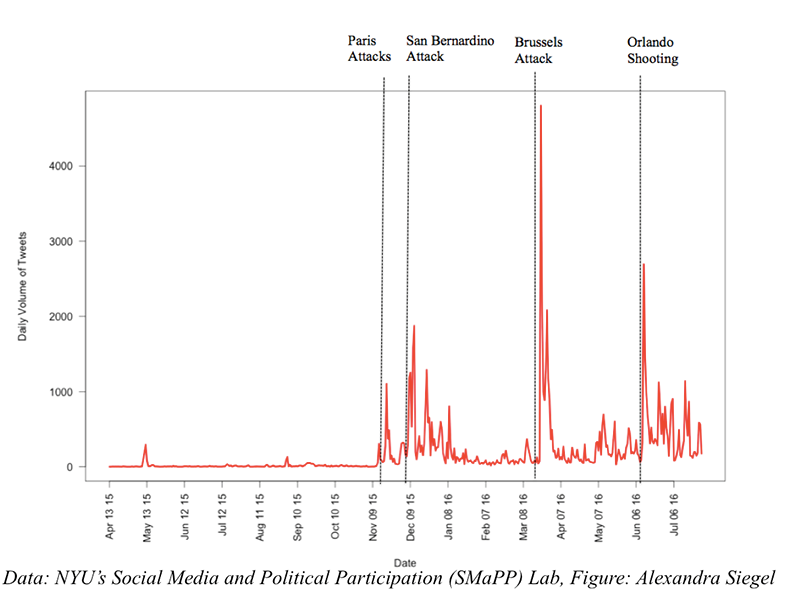
Graph shows the daily volume of tweets mentioning anti-Muslim terms in a dataset of all tweets mentioning Clinton, Trump, or Election 2016. Data was collected using the Twitter streaming API through NYU’s Social Media and Political Participation (SMaPP) Lab.
The largest spikes in anti-Muslim election-related tweets occurred following the Brussels attacks and the Orlando attack. We also observe smaller spikes following the Paris attack and the San Bernardino attack.
Daily Mentions of Anti-Islamophobia Tweets
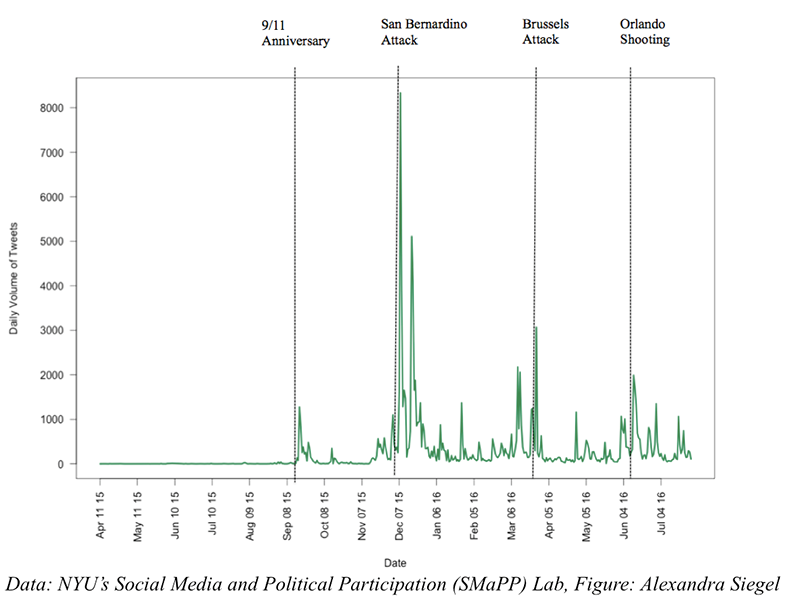
Graph shows the daily volume of tweets mentioning anti-Islamophobia terms in a dataset of all tweets mentioning Clinton, Trump, or Election 2016. Data were collected using the Twitter streaming API through NYU’s Social Media and Political Participation (SMaPP) Lab.
Daily Mentions of Anti-Muslim Rhetoric: Facebook Comments on Clinton and Trump Pages
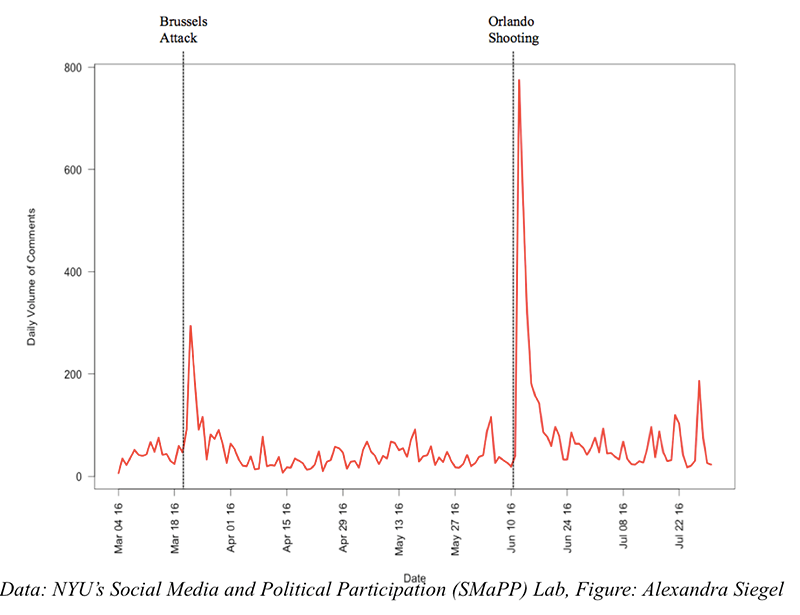
Graph shows spikes in daily anti-Muslim posts on both the Trump and Clinton Facebook pages. When pages were examined individually, spikes occurred at the same points on each page. Both supporters and those who oppose each candidate write on each page.
Daily Mentions of anti-Islamophobia Rhetoric: Facebook Comments on Clinton and Trump Pages
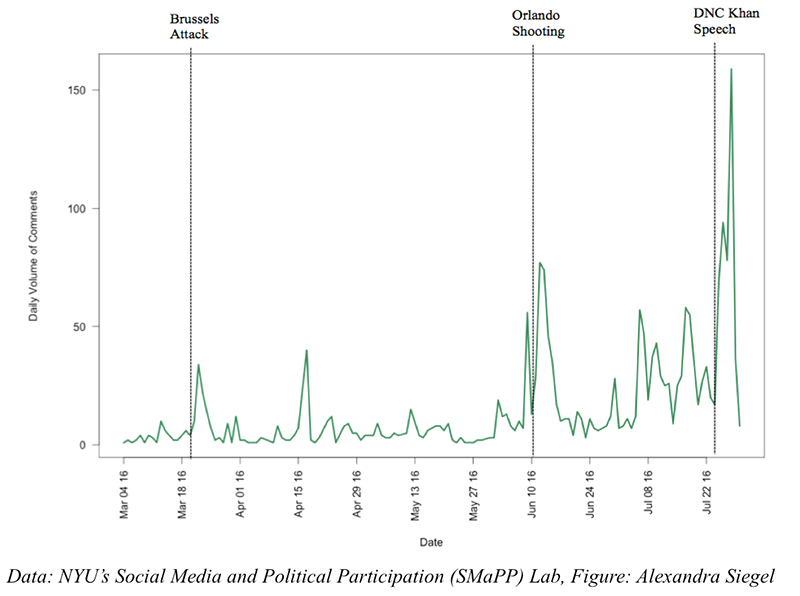

Graph shows spikes in daily mentions of anti-Islamophobia terms on both the Trump and Clinton Facebook pages. When pages were examined individually, spikes occurred at the same points on each page. Both supporters and those who oppose each candidate write on each page.
Rafia Zakaria is an attorney, human rights activist, and the author of The Upstairs Wife: An Intimate History of Pakistan (Beacon 2015), which was named one of Newsweek’s Top 10 non-fiction books of 2015. Her work has appeared in The Guardian Books, The New York Times Book Review, The New Republic, The New York Times, Al Jazeera America, Dissent, Guernica, and various other venues. Her next book will be published by Bloomsbury in 2017. She served on the Board of Amnesty International USA 2009-2015.


